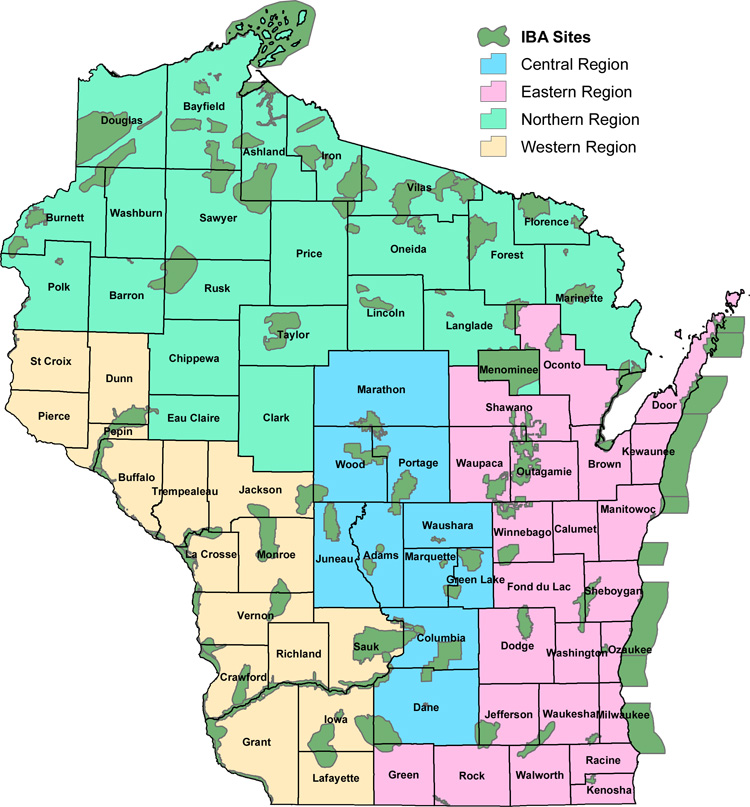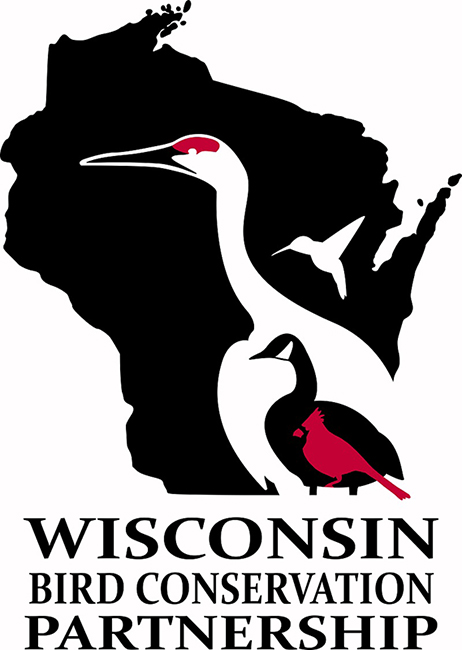A state bird organization is entering 2020 with new energy, a new name, a new logo, a new hire and a major new project – all aimed at recapturing its role as one of the nation’s leaders in mobilizing statewide bird conservation.
The Wisconsin Bird Conservation Initiative (WBCI) is now the Wisconsin Bird Conservation Partnership (WBCP), highlighting its structure and the mission it established when it was hatched in 2001 as “a cooperative partnership to deliver the full spectrum of bird conservation emphasizing volunteer stewardship.”
The bold new logo, emphasizing not only the organization’s scope but the range of avian species it shares concern for, was designed by Ryan Steiskal, of Milwaukee, after a statewide competition.
WBCP’s re-launch is timed to the hire of Tom Prestby as the organization’s Important Bird Areas assessment specialist. Prestby is an environmental scientist with GEI Consultants in Green Bay and a major contributor to recently completed field work for the second Wisconsin Breeding Bird Atlas.
Prestby will lead a one-year project with funding provided by multiple partners. The effort was kicked off last year by a generous challenge gift from Laura DeGolier of Fond du Lac. Additional donors include the Wisconsin Department of Natural Resources, the Wisconsin Society for Ornithology, The Nature Conservancy, the Natural Resources Foundation of Wisconsin's Bird Protection Fund, Gathering Waters, the American Bird Conservancy, Bird City Wisconsin, Wisconsin Metro Audubon and several additional individual donors.
Timing is everything, and the IBA assessment has the potential for tapping the energy of some 1,800 WBBA II volunteers who will be coming down from an “Atlas high” at the end of the 2019 breeding season and who might be tapped to support efforts in their areas to put IBAs to work for conservation.
WBCP itself is emerging from several years of diminished activity after losing its fulltime state coordinator amid funding cuts at the DNR and is evolving under a new strategic plan completed in 2018. Its partnership encompasses more than 150 organizations around the state, including bird clubs, hunting and fishing groups, government agencies, land trusts, nature centers, environmental groups, universities, and businesses.
Notable recent additions to its Steering Committee include key representatives from Gathering Waters (a coalition of state land trusts), the Western Great Lakes Bird and Bat Observatory, Bird City Wisconsin, the Cofrin Center for Biodiversity at UW-Green Bay and the American Transmission Co.
WBCI has accomplished a lot in two decades; examples include:
- Helping the public understand risks to birds and how they can be reduced, including publication of issue papers on cats, climate change, deer herbivory, window collisions, wind power, birding ethics, pesticides, and lead poisoning.
- Drafting the Wisconsin All Bird Conservation Plan, a major undertaking, synthesizes the conservation needs and issues for 116 priority bird species and provides recommendations for habitat protection, restoration, and management that will have the greatest impact on state bird populations.
- Helping establish Bird City Wisconsin, modeled on The Arbor Day Foundation’s Tree City USA, to ensure all of Wisconsin’s communities and residents maintain healthy populations of birds and grow an appreciation for them.
- Launching and coordinating citizen-science surveys for owls, nightjars, secretive marsh birds, and earlier, Red-shouldered Hawks; aiding in establishing the Wisconsin eBird portal; guiding efforts of the Midwest Coordinated Bird Monitoring Network.
- Helping to develop the Great Wisconsin Birding and Nature Trail, a set of birding guides for five regions of the state, and an accompanying bird checklist booklet.
- Hosting statewide meetings to highlight bird conservation issues. Meeting topics have included “Wisconsin Urban Bird Workshop,” “Neotropical Migrants: Insuring Their Return,” “Power of Partnerships," “Wisconsin Bird Education Summit.” "Making Our Private Lands Count for Birds” and "SOS for Our Aerial Insectivores."
The new strategic plan vowed to put the state’s IBAs to work for bird conservation. When 92 “critical sites for the conservation and management of Wisconsin’s birds” were identified in a 240-page book published in 2007, Wisconsin was seen as a leading partner in a global network of more than 12,000 IBAs identified in 200 countries that exists to identify and encourage voluntary protection of critical habitat for birds throughout their annual lifecycle — breeding, migration, wintering.

IBA Statewide Map 2/2020
However, a decade of shifting state priorities marked by declining funding and staffing for WBCI left that conservation phase for many IBAs in the lurch. Led by Chair Karen Etter Hale, the Steering Committee established an eight-member Committee on IBA Oversight and Fundraising chaired by Carl Schwartz (a board member for WSO, Bird City and the Observatory) to raise the funds needed, draw up a work plan and hire the needed staff. The Observatory agreed to serve as fiscal agent for the project, which will be managed by WBCP’s IBA Committee.
In Wisconsin, WBCP coordinates the state’s 93 IBAs (the Milwaukee County Parks were added in 2019), but its efforts to date have focused exclusively on identification and designation of new areas. While this is an important first step, WBCP recognizes that proactive coordination will be critical for conservation efforts within IBAs to reach their full potential.
The goal established for Prestby is to develop a process for assessing and prioritizing Wisconsin IBAs based on a range of criteria. Data collection and analysis will include: 1) a general assessment of the conservation values of each existing IBA, 2) defining the short- and long-term threats to habitat loss and degradation and their potential resilience in the face of climate change, and 3) contacting local stakeholders to assess the human capital and local organizational capacity.
Prestby will work with the WBCP IBA Committee, the DNR, local stakeholders and other experts to develop the assessment and then identify conservation opportunities and identify strategies (including key stakeholders and funding opportunities) to enact partnerships in 5 to 15 IBAs
IBAs are distinguishable due to their ornithological importance from surrounding areas. They vary considerably in size and may include public land, private land, or a mix of both. Recognition of a site as an IBA, however, does not confer any legal status or regulatory requirements. But the IBA designation can foster voluntary management of areas to protect and enhance their bird populations, can be used in land management planning to emphasize an area’s importance to birds, and can help justify funding to support habitat enhancement of existing lands and the expansion of protected areas for the benefit of birds.
WBCP’s strategic plan: http://www.wisconsinbirds.org/wp-content/uploads/2018/07/WBCI-Strategic-Plan-2018.pdf
A fuller look at WBCI’s accomplishments: http://www.wisconsinbirds.org/wp-content/uploads/2019/03/WBCIAccomplishments_2002-17.pdf


